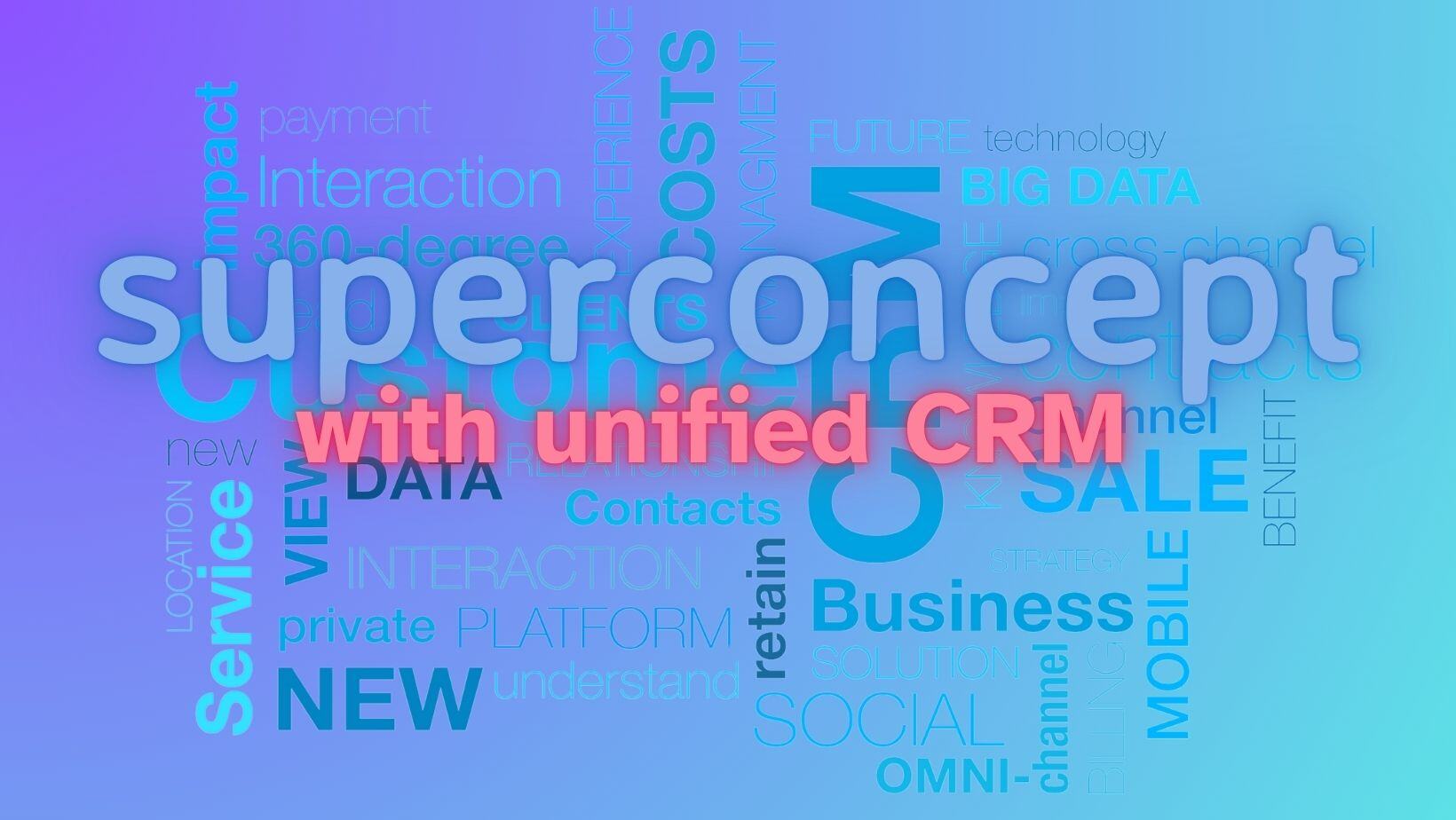Introduction: Why We Need a New Approach to CRM
In an era defined by an overwhelming barrage of communication, businesses are grappling with unprecedented challenges. Emails, social media notifications, instant messages, and countless other forms of communication flood our daily lives, leaving both businesses and consumers struggling to find meaningful connections amidst the noise. The result is a paradox: despite having more ways to communicate than ever before, genuine engagement is becoming increasingly rare.
But within this challenge lies an extraordinary opportunity—one that taps into the very essence of what makes businesses thrive: the ability to connect deeply with customers, to build trust, and to create experiences that resonate on a personal level. To seize this opportunity, we must rethink how we approach Customer Relationship Management (CRM). It’s time to elevate CRM from a tool to a super concept—one that transcends its traditional boundaries and becomes a guiding philosophy for navigating the complexities of modern communication.
This narrative isn’t just about CRM as a system or software; it’s about transforming the way businesses relate to their customers, using the very challenges of communication overload to foster stronger, more authentic relationships. By exploring why this evolution is not only necessary but also pivotal to future success, we can unlock new strengths and possibilities that resonate deeply with every reader.
The Challenge: Communication Overload and Its Impact on Businesses
The Noise that Drowns Out Connection
Imagine being in a crowded room where everyone is shouting. You’re trying to have a conversation, but the noise is so overwhelming that you can barely hear the person standing right next to you. This is the reality of modern communication. Businesses are like those people in the crowded room, trying to connect with customers who are equally bombarded with messages, ads, and information. The traditional ways of reaching out—emails, ads, social media posts—are losing their effectiveness as they get lost in the noise.
This communication overload doesn’t just make it harder to reach customers; it erodes trust, weakens relationships, and diminishes the value of every interaction. Customers become skeptical, disengaged, and even resentful of the constant bombardment. For businesses, this means that the very tools once relied upon to build relationships are now contributing to their breakdown.
The Risk of Being Left Behind
In this chaotic environment, businesses that fail to adapt are at risk of being left behind. Those who continue to rely on outdated CRM practices may find themselves unable to compete, as customers increasingly seek out brands that can cut through the noise and offer genuine, personalized interactions. The stakes are high, and the need for a new approach is urgent.
But what if, instead of seeing communication overload as a barrier, we viewed it as an opportunity? What if businesses could turn this challenge into a source of strength—by redefining how they manage customer relationships in a way that not only survives the chaos but thrives in it?
The Opportunity: Redefining CRM as a Super Concept
A New Philosophy for a New Era
The answer lies in transforming CRM from a mere tool into a super concept—a comprehensive framework that guides every aspect of customer interaction, from strategy to execution. By broadening the scope of CRM, businesses can not only manage relationships more effectively but also turn the challenges of communication overload into opportunities for deeper engagement, trust-building, and innovation.
This new approach to CRM isn’t just about adding more features or tools; it’s about fundamentally rethinking how businesses relate to their customers. It’s about recognizing that in a world where communication is overwhelming, the true value of CRM lies in its ability to create clarity, foster trust, and deliver experiences that resonate on a human level.
Tapping into Core Strengths
At the heart of this transformation is the realization that the greatest strengths of a business—its ability to connect, empathize, and innovate—are also the keys to overcoming communication overload. By focusing on these core strengths, businesses can use CRM not just to manage relationships but to elevate them, creating connections that are not only effective but also deeply meaningful.
For example, businesses that excel in personalization can leverage CRM to create experiences tailored to individual customers, cutting through the noise with messages that truly matter. Those with a strong reputation for trust can use CRM to enhance transparency and accountability, building even greater customer loyalty. And companies known for innovation can harness CRM to co-create value with customers, turning them into active participants in the brand’s journey.
The New Services and Tools: Harnessing CRM’s Full Potential
To bring this new vision of CRM to life, a range of innovative services and tools have emerged, each designed to address specific aspects of the CRM super concept. These services don’t just solve problems; they tap into the strengths of a business, amplifying its ability to connect, build trust, and create value in an era of communication overload.
1. Relationship Lifecycle Management Services: Nurturing Long-Term Connections
Why It Matters
At its core, every business relationship is a journey. It begins with the first interaction and, ideally, evolves into a long-term connection built on trust and mutual benefit. In an era of communication overload, managing this journey effectively is more critical than ever. Relationship Lifecycle Management (RLM) services are designed to help businesses nurture these connections over time, ensuring that each stage of the relationship is carefully managed and optimized.
The Strength It Taps Into
RLM services tap into a business’s strength in customer care and loyalty. By focusing on the entire lifecycle of the customer relationship, these services enable businesses to build stronger, more enduring connections that can withstand the challenges of modern communication.
How It Works
-
Automated Follow-Up Systems: These systems use AI to send personalized follow-up messages at key points in the customer lifecycle, ensuring continuous engagement without overwhelming the customer with irrelevant communication.
-
Customer Journey Mapping Tools: These tools help businesses visualize the customer journey, identifying opportunities for deeper engagement and ensuring that no stage of the relationship is neglected.
-
Lifecycle Analytics Platforms: By providing insights into the effectiveness of lifecycle management strategies, these platforms enable businesses to continuously refine and improve their approach.
2. Trust and Reputation Management Solutions: Building and Maintaining Trust
Why It Matters
In a world where communication is overwhelming, trust becomes a precious commodity. Customers are increasingly wary of brands that bombard them with messages, and any misstep can quickly erode hard-earned trust. Trust and Reputation Management (TRM) solutions are designed to help businesses maintain and enhance customer trust, even in the most challenging environments.
The Strength It Taps Into
TRM solutions tap into a business’s strength in ethics and integrity. By focusing on trust and reputation, these services ensure that a business’s core values are reflected in every customer interaction, building a foundation of trust that can withstand the noise of modern communication.
How It Works
-
Reputation Monitoring Tools: These tools track mentions of a brand across various platforms, providing real-time alerts for potential issues and enabling businesses to address them before they escalate.
-
Trust-Building Communication Platforms: Designed to facilitate transparent and secure communication, these platforms help businesses build and maintain customer trust by ensuring that every interaction is guided by ethical standards.
-
Crisis Management Services: When things go wrong, crisis management services help businesses respond quickly and effectively, protecting their reputation and maintaining customer confidence.
3. Experience Personalization Extensions: Creating Meaningful Interactions
Why It Matters
In an era of communication overload, customers are bombarded with generic messages that fail to resonate. Experience Personalization (EP) extensions are designed to cut through the noise by delivering personalized interactions that reflect each customer’s unique needs and preferences.
The Strength It Taps Into
EP extensions tap into a business’s strength in customer understanding and personalization. By focusing on tailored experiences, these services enable businesses to connect with customers on a personal level, making each interaction more meaningful and effective.
How It Works
-
Personalization Engines: These AI-driven tools analyze customer data to deliver personalized recommendations, content, and offers in real-time, ensuring that each message is relevant and valuable.
-
Customizable User Interfaces: By allowing customers to personalize their interaction experience, these interfaces create a sense of ownership and engagement, making each interaction more meaningful.
-
Dynamic Content Management Systems: These systems deliver personalized content based on user behavior, location, and other data points, ensuring that each interaction is tailored to the customer’s needs.
4. Engagement and Interaction Design Services: Enhancing Customer Engagement
Why It Matters
Customer engagement is more critical than ever, but it’s also more challenging in an environment where attention is limited, and communication channels are fragmented. Engagement and Interaction Design (EID) services are designed to create intuitive and compelling customer touchpoints, ensuring that every interaction is engaging and effective.
The Strength It Taps Into
EID services tap into a business’s strength in creativity and innovation. By focusing on the design of customer interactions, these services enable businesses to create engaging experiences that stand out in a crowded communication landscape.
How It Works
-
Omnichannel Engagement Platforms: These platforms ensure a seamless customer experience across all channels, from social media to email to in-store interactions, making it easier for customers to engage with the brand.
-
Interactive AI Chatbots: These AI-driven chatbots engage customers in personalized conversations, providing support, recommendations, and information in real-time, enhancing the customer experience.
-
Gamified Interaction Tools: By incorporating gamification elements into customer interactions, these tools increase engagement and retention, turning routine interactions into memorable experiences.
5. Value Co-Creation Platforms: Innovating Together with Customers
Why It Matters
Customers today want more than just products or services—they want to be part of the process. Value Co-Creation (VCC) platforms are designed to enable businesses to collaborate with customers, turning them into active participants in the brand’s journey.
The Strength It Taps Into
VCC platforms tap into a
business’s strength in innovation and collaboration. By involving customers in the creation process, these platforms not only enhance the final product but also build a stronger, more loyal customer base.
How It Works
-
Collaborative Product Development Platforms: These platforms enable businesses to engage customers in the product development process, gathering feedback and ideas that shape the final offering.
-
Crowdsourcing Solutions: By tapping into the collective intelligence of their customer base, businesses can solve problems, generate ideas, and co-create content or products, enhancing both innovation and customer engagement.
-
Customer-Led Innovation Hubs: These dedicated spaces, whether virtual or physical, allow customers to collaborate with the company’s R&D teams, driving innovation and ensuring that the final product meets real-world needs.
6. Data-Driven Insights Services: Making Informed Decisions
Why It Matters
In a world overwhelmed by information, the ability to make data-driven decisions is a critical advantage. Data-Driven Insights (DDI) services leverage customer data to generate actionable insights, helping businesses navigate the complexities of modern communication and make informed decisions.
The Strength It Taps Into
DDI services tap into a business’s strength in analysis and strategy. By focusing on data-driven insights, these services enable businesses to anticipate customer needs, optimize interactions, and drive more effective outcomes.
How It Works
-
Predictive Analytics Tools: These tools use machine learning to analyze historical data and predict future customer behaviors and trends, enabling businesses to stay ahead of the curve.
-
Customer Segmentation Platforms: By segmenting customers based on various data points, these platforms allow for more targeted marketing and personalized experiences, ensuring that each interaction is relevant and effective.
-
Real-Time Analytics Dashboards: These dashboards provide real-time insights into customer interactions, enabling businesses to make informed decisions on the fly and respond to changing customer needs.
7. Ethical Customer Stewardship Solutions: Upholding Integrity in Every Interaction
Why It Matters
As concerns about data privacy and ethical practices grow, businesses must ensure that their customer interactions are guided by integrity and transparency. Ethical Customer Stewardship (ECS) solutions are designed to help businesses uphold these values, ensuring that every customer interaction is ethical and responsible.
The Strength It Taps Into
ECS solutions tap into a business’s strength in ethics and integrity. By focusing on ethical stewardship, these services ensure that a business’s core values are reflected in every customer interaction, building trust and loyalty.
How It Works
-
Privacy Management Tools: These tools help businesses manage customer data in compliance with privacy regulations, ensuring transparency and security in every interaction.
-
Ethical AI Solutions: Designed to operate within ethical guidelines, these AI systems avoid biases and ensure fair treatment of all customers, upholding the highest standards of integrity.
-
Transparency Platforms: By providing customers with clear information about how their data is used and how the business operates, these platforms foster trust and accountability, ensuring that every interaction is guided by ethical principles.
8. Sustainability and Social Responsibility Services: Aligning Business with Broader Societal Goals
Why It Matters
In an era where customers increasingly value sustainability and social responsibility, businesses must align their strategies with broader societal goals. Sustainability and Social Responsibility (SSR) services help companies integrate these values into their CRM strategies, enhancing both customer loyalty and brand reputation.
The Strength It Taps Into
SSR services tap into a business’s strength in corporate responsibility and ethics. By focusing on sustainability and social responsibility, these services ensure that a business’s actions are aligned with the values of its customers and society as a whole.
How It Works
-
Sustainability Reporting Tools: These tools enable businesses to track and report on their sustainability efforts, providing transparency to customers and stakeholders and demonstrating a commitment to corporate responsibility.
-
Green CRM Platforms: Designed to support environmentally friendly practices, these CRM systems help businesses reduce their carbon footprint and minimize environmental impact, aligning their operations with sustainability goals.
-
Social Impact Measurement Solutions: By measuring the social impact of business activities, these solutions help companies align their CRM strategies with their social responsibility goals, ensuring that their actions have a positive impact on society.
9. Cross-Cultural Relationship Management Services: Navigating a Global Customer Base
Why It Matters
As businesses expand globally, the ability to manage customer relationships across different cultures and regions becomes increasingly important. Cross-Cultural Relationship Management (CCRM) services help businesses navigate the diverse expectations and norms of a global customer base, ensuring that every interaction is relevant and effective.
The Strength It Taps Into
CCRM services tap into a business’s strength in cultural sensitivity and adaptability. By focusing on cross-cultural relationship management, these services ensure that businesses can build strong relationships with customers in different regions, fostering loyalty and trust across cultural boundaries.
How It Works
-
Cultural Adaptation Tools: These tools help businesses adapt their CRM strategies to different cultural contexts, ensuring that their interactions are relevant and effective in every region.
-
Global CRM Platforms: Designed to support multilingual and multicultural customer interactions, these platforms enable businesses to engage with customers worldwide, ensuring that their communications resonate across cultures.
-
Cross-Cultural Training Services: By providing training for employees on cultural sensitivity and effective communication across cultures, these services ensure that every interaction is guided by an understanding of cultural differences and expectations.
10. Customer Empowerment and Advocacy Platforms: Turning Customers into Brand Advocates
Why It Matters
In a world where customers have more power and influence than ever before, businesses must find ways to empower their customers and turn them into advocates for the brand. Customer Empowerment and Advocacy (CEA) platforms are designed to do just that, giving customers a voice and ensuring that they feel valued and heard.
The Strength It Taps Into
CEA platforms tap into a business’s strength in customer engagement and community building. By focusing on customer empowerment and advocacy, these platforms help businesses create loyal customers who are not only satisfied but also passionate about the brand.
How It Works
-
Customer Feedback Loops: These systems allow customers to provide feedback in real-time, with businesses responding and adapting quickly to meet their needs, ensuring that customers feel heard and valued.
-
Advocacy Programs: By encouraging customers to share their positive experiences and advocate for the brand, these programs build a community of loyal customers who actively promote the business.
-
User-Generated Content Platforms: These platforms enable customers to create and share content related to the brand, fostering a sense of ownership and community and turning customers into active participants in the brand’s journey.
Conclusion: Transforming Challenges into Strengths Through CRM
As businesses navigate the complexities of communication overload and the disruption of traditional communication models, the evolution of CRM as a super concept offers a path forward—one that turns challenges into opportunities and taps into the very strengths that make businesses successful.
By embracing new professional services and tools—such as Relationship Lifecycle Management services, Trust and Reputation Management solutions, and Experience Personalization extensions—businesses can not only survive in this challenging environment but thrive. These innovations, driven by the expanded scope of CRM, enable businesses to connect more deeply with customers, build trust, and create experiences that resonate on a human level.
In this new era, CRM is not just about managing customer interactions; it’s about rethinking how businesses relate to their customers, employees, and society as a whole. By leveraging the new services and tools emerging from the CRM super concept, businesses can turn the challenges of communication overload into opportunities for deeper, more meaningful connections. This approach will be key to thriving in the modern landscape, where effective communication is both a challenge and a crucial differentiator.




